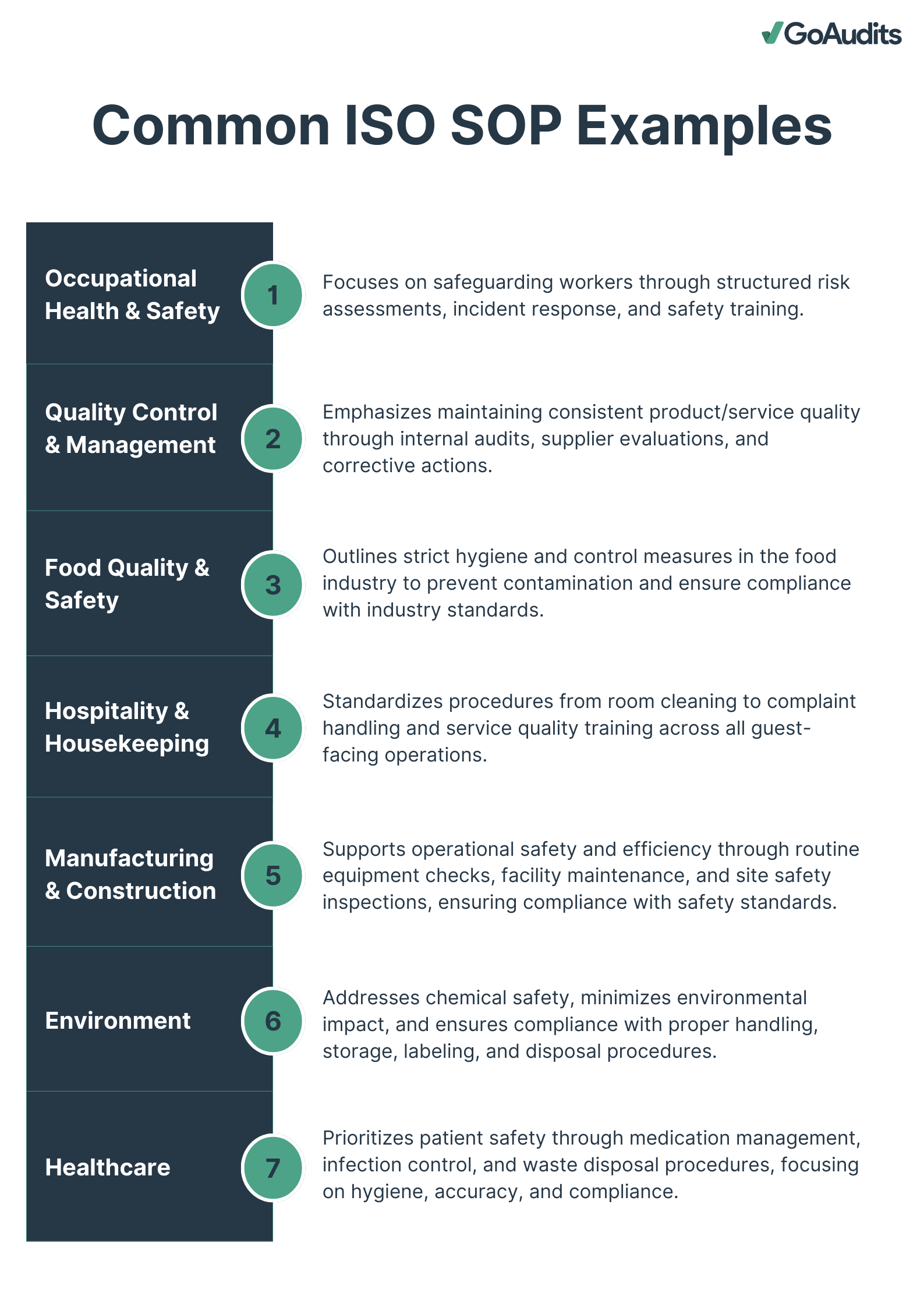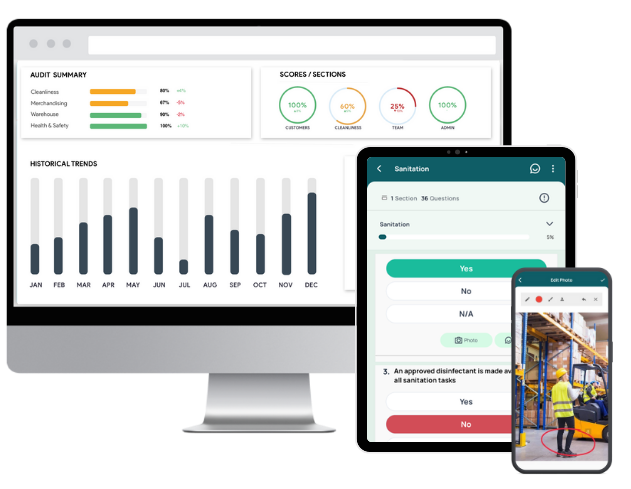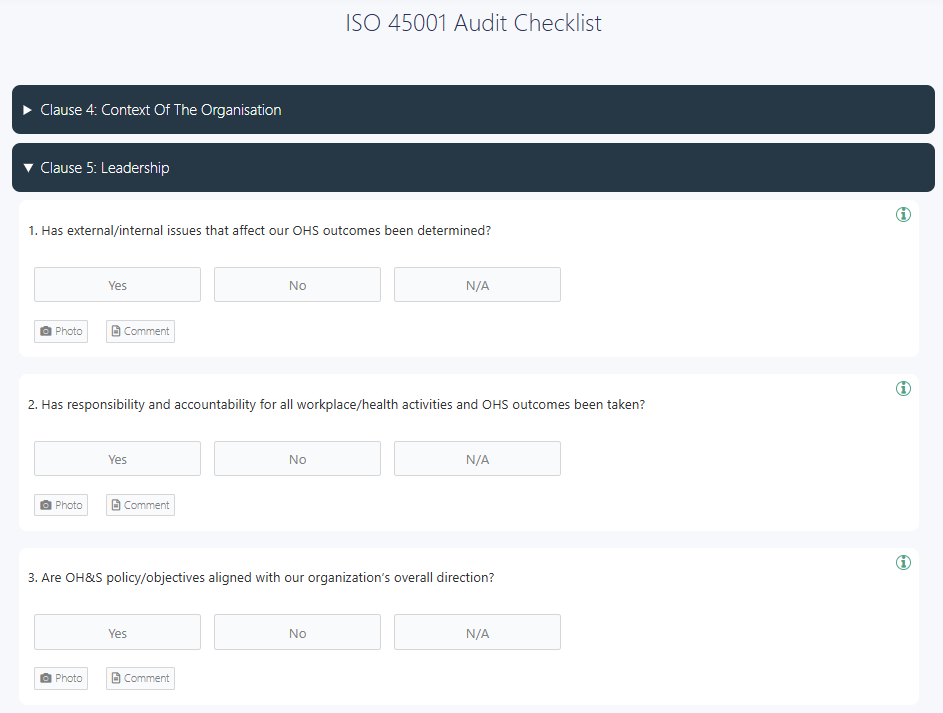ISO standard operating procedures (SOPs) developed in alignment with ISO requirements are essential for ensuring consistency, quality, and regulatory compliance across your organization. They define how important processes should be executed, controlled, and improved following internationally recognized ISO standards. ISO SOPs must be clear, concise, and purpose-driven. They should outline responsibilities, establish procedures, and incorporate controls to minimize variation. ISO SOPs also require proper documentation practices, version control, employee training, and regular review. This ensures each procedure reflects current operations, supports continual improvement, and contributes to overall business objectives.
This article will discuss how ISO SOPs help you enhance operational efficiency, ensure accountability, improve quality, and increase transparency, especially if you’re preparing for certification. We have also listed free and customizable ISO checklists to help you comply with different ISO standards.
ISO Standard Operating Procedures: An Overview
ISO SOPs are detailed, written instructions that describe how to perform routine or repetitive organizational activities in a consistent and controlled manner. The main goal is to ensure efficiency, quality output, and uniformity of performance. They are essential components of management systems required for minimizing miscommunication and ensuring compliance with various ISO standards.
There is no mandatory format required by ISO. ISO SOP templates can be presented as checklists, flowcharts, step-by-step instructions, annotated photos, or video guides.
Common ISO SOP Examples
Below are detailed ISO SOP examples tailored to specific industries:

Occupational Health and Safety (OHS)
Occupational health and safety involves minimizing workplace hazards and ensuring employee safety.
- Hazard Identification & Risk Assessment: Regularly inspect the workplace to identify potential hazards. Evaluate the risks associated with each hazard and implement control measures to mitigate them.
- Incident Reporting & Investigation: Establish a clear procedure for reporting incidents. Investigate each incident to determine root causes and implement corrective actions to prevent recurrence.
- Emergency Response & Action Plan: Develop comprehensive emergency response plans, including evacuation procedures, emergency contacts, and roles and responsibilities during emergencies.
- Personal Protective Equipment (PPE) Procedures: Conduct hazard assessments and PPE inspections to determine necessary PPE. Use PPE checklists to provide training on proper usage, maintenance, and storage of PPE.
- Ergonomics: Implement ergonomic assessments to design workstations that reduce strain and prevent musculoskeletal disorders.
- Safety Training & Awareness: Regularly conduct training sessions to educate employees about safety protocols, emergency procedures, and the importance of reporting hazards.
Quality Control and Management
Maintaining high-quality standards requires systematic procedures to monitor and improve processes.
- Internal Audit: Periodically assess the effectiveness of the quality management system to ensure compliance with ISO standards and identify areas for improvement.
- Supplier Evaluation: Evaluate suppliers based on their ability to meet quality requirements, delivery schedules, and compliance with standards. You can use the GoAudits supplier self-assessment form, vendor assessment checklist, and supplier quality audit checklist to perform supplier audits and ensure a solid supplier quality management system.
- Corrective Action: Use GoAudits corrective action software to identify non-conformities, determine their root causes, and implement actions to prevent recurrence.
- Process Control: Monitor and control processes to ensure outputs meet specified requirements, using statistical methods where applicable.
- Quality Assurance: Establish procedures to ensure that products and services consistently meet customer and regulatory requirements.
Food Safety Management
Ensuring quality and safety in the food & beverage industry involves meticulous procedures to prevent contamination and ensure compliance.
- Cleaning and Sanitization: Implement detailed cleaning procedures and schedules for equipment and facilities to prevent contamination.
- Food Handling and Storage: Define protocols for receiving, storing, and handling food to maintain quality and safety.
- HACCP: Identify potential hazards in the food production process and establish critical control points to mitigate risks.
- Food Hygiene: Ensure personal hygiene practices among staff, including handwashing and use of protective clothing.
- Allergen Management: Develop procedures to prevent cross-contamination and accurately label allergens in food products.
- Pest Control: Implement regular inspections and control measures to prevent pest infestations in food-handling areas.
Hospitality
Delivering exceptional guest experiences requires standardized procedures across various operations in the hospitality sector.
- Room Cleaning: Establish detailed cleaning protocols to ensure rooms meet hygiene and presentation standards.
- Guest Complaint Handling: Develop a structured approach to address guest complaints promptly and effectively, aiming to resolve issues and enhance satisfaction.
- Service Quality: Implement training programs and performance evaluations to maintain high service standards across all departments.
Manufacturing and Construction
Safety and efficiency in manufacturing and construction are achieved through rigorous procedures and maintenance protocols.
- Equipment Inspections and Maintenance: Schedule regular inspections and maintenance of equipment to prevent failures and ensure operational efficiency.
- Site Safety Inspections: Conduct routine safety inspections to identify hazards and ensure compliance with safety regulations.
- Facility Maintenance: Develop maintenance schedules for facilities to ensure a safe and functional working environment.
Environment
Proper handling and storage of chemicals are vital to prevent environmental contamination and ensure safety.
- Chemical Handling and Storage: Establish procedures for the safe handling, storage, and disposal of chemicals, including proper labeling and use of safety data sheets.
Healthcare
Maintaining patient safety and hygiene standards in healthcare settings requires meticulous procedures.
- Medication Management: Implement protocols for prescribing, dispensing, and administering medications to ensure patient safety.
- Infection Control: Develop comprehensive infection control procedures, including hand hygiene, sterilization, and use of personal protective equipment.
- Waste Management: Establish procedures for the segregation, handling, and disposal of medical waste to prevent contamination and comply with regulations.
Key ISO Standards that Will Benefit from ISO SOPs
Here’s how SOPs can benefit each of the key ISO standards:
ISO 9001: Quality Management Systems
ISO 9001 emphasizes a process-based approach to ensure consistent product and service quality. ISO SOPs standardize processes to reduce variability, ensure consistent product and service quality, facilitate training and onboarding, and provide a basis for performance evaluation and continual improvement.
👉 GoAudits ISO 9001 software offers a wide range of ISO 9001 checklists to help you perform ISO 9001 audits, document procedures, identify inefficiencies, and implement corrective actions effectively.
- ISO 9001 Checklist
- ISO 9001 Audit Checklist
- ISO 9001 2015 Audit Checklist
- ISO 9001-2015 Gap Analysis Checklist
- ISO 9001:2015 Supplier Audit Checklist – Manufacturing
ISO 45001: Occupational Health and Safety Management Systems
ISO 45001 focuses on creating a safe and healthy workplace. ISO SOPs contribute by defining safety protocols and emergency procedures, ensuring compliance with legal and regulatory requirements, promoting a culture of safety through clear communication, and reducing workplace incidents and associated costs.
👉 Use this free ISO 45001 audit checklist to perform internal ISO 45001 audits, proactively managing risks and enhancing employee well-being.
ISO 22000: Food Safety Management Systems
ISO 22000 integrates principles of hazard analysis and critical control points (HACCP) to ensure food safety. ISO SOPs are essential for managing critical control points in food production, ensuring traceability and recall procedures, maintaining hygiene and sanitation standards, and complying with food safety standards.
GoAudits food quality management software offers the following ISO 22000 internal audit checklists to help you minimize food safety risks and enhance consumer confidence.
- ISO 22000 Internal Audit Checklist
- FSSC 22000 Version 6 Gap Analysis
- ISO 22000 Food Safety Checklist (FSMS)
- FSSC 22000 Version 5 Audit Checklist
👉 You can also try out the GoAudits HACCP app & software to digitize HACCP SOP into actionable checklists and perform internal HACCP audits.
Alternatively, here are some pre-built HACCP checklists GoAudits offer. You can sign up for free and start using these checklists.
- Plan for HACCP
- HACCP Audit Checklist
- HACCP-Based SOPs
- HACCP Plan Self-Assessment Checklist
- HACCP Food Safety Checklist
- HACCP Internal Audit Checklist
- BRC Audit Checklist Food Safety Plan – HACCP (Clause 2)
ISO 14001: Environmental Management Systems
ISO 14001 provides a framework for managing environmental responsibilities. ISO SOPs support this by identifying and controlling environmental aspects and impacts, ensuring compliance with environmental legislation, promoting resource efficiency and waste reduction, and facilitating continuous environmental performance improvement.
👉 Use the GoAuduts ISO 14001 software to perform effective ISO 14001 audits, systematically address environmental challenges, and demonstrate sustainability commitments.
Here are some checklists you can use:
- ISO 14001 Requirements Checklist
- ISO 14001 Self-Assessment Checklist
- ISO 14001 Internal Audit Checklist
ISO 50001: Energy Management Systems
ISO 50001 focuses on energy performance improvement. ISO SOPs help monitor and measure energy consumption, implement energy-efficient practices, set and review energy objectives and targets, and ensure compliance with energy-related regulations.
👉 You can use the GoAudits ISO 50001 checklist and ISO 50001 internal audit checklist to standardize energy management processes, save costs, and ensure environmental benefits.
ISO 37301: Compliance Management Systems
ISO 37301 provides requirements for establishing, developing, and maintaining an effective compliance management system. ISO SOPs are essential for defining roles and responsibilities for compliance, implementing procedures to meet legal and regulatory obligations, conducting compliance risk assessments, and monitoring and reporting compliance performance.
👉 ISO 19600 is now withdrawn. The ISO 19600:2014 standard, which provided guidelines for compliance management systems, was officially withdrawn with the publication of ISO 37301:2021 in April 2021. ISO 37301 replaced ISO 19600 and introduced requirements, rather than just recommendations for the implementation of a compliance management system.
GoAudits ISO compliance software offers a free and customizable ISO 37301 checklist to ensure that compliance is integrated into daily operations and corporate culture.
Here are some other ISO standards that can benefit from the use of ISO SOP templates:
ISO 31000: Risk Management Guidelines
ISO 31000 offers a comprehensive framework for managing risks across organizations. It emphasizes principles such as integration, structure, and customization in risk management processes.
👉 Use this GoAudits ISO 31000 risk management checklist to ensure consistency in risk assessment, enhance decision-making, and improve communication.
ISO 13485: Medical Devices – Quality Management Systems
ISO 13485 specifies requirements for a quality management system (QMS) in the medical device industry, focusing on regulatory compliance and product safety. It also emphasizes the importance of efficient training.
👉 GoAudits offers this ISO 13485 checklist to help you comply with the quality management system requirements for medical devices, and ensure product consistency and safety.
ISO/IEC 27001: Information Security Management Systems
ISO/IEC 27001 provides a framework for establishing, implementing, and maintaining an information security management system (ISMS) to protect sensitive information.
GoAudits offers this ISO 27001 checklist to help you perform internal ISO 27001 audits, mitigate risks, ensure compliance, and quickly respond to incidents.
ISO/IEC 8801: Data Standard Operating Procedure
ISO/IEC 8801 focuses on standard operating procedures for evaluating modeling from 3D scanned data, particularly in information technology and 3D printing contexts. ISO SOPs are important for data integrity, process standardization, and quality assurance.
Essential Elements of ISO SOP Templates
Here’s what each element of an ISO SOP template should include:
- SOP Title: Use a concise, descriptive title that clearly identifies the activity or process. Avoid generic phrases and be specific to make the SOP easily identifiable in a document control system.
- Purpose and Scope: This section defines why the SOP exists and where it applies. Explain the objective of the procedure, what outcome it supports, and why it’s necessary. Identify the departments, systems, processes, or equipment the SOP governs. Specify any inclusions and exclusions to eliminate ambiguity.
- Roles and Responsibilities: List every position or team involved in executing or overseeing the procedure. Clarify who does what and who is accountable at each stage.
- Related Documents and Document Control: Include references to all documents or records linked to the SOP (e.g., forms, policies, work instructions). Mention how these are identified, managed, and stored.
- Procedure: This is the core of the ISO SOP template. Outline the process in clear, logically ordered steps. Each step should be short and direct and include safety or compliance checks if needed.
- Revision History: Provide a table or section that tracks every change made to the ISO SOP template. Include revision numbers, effective date, summary of changes, and who approved the changes.
How to Develop & Implement ISO SOPs?
The following structured approach will guide you through the process of developing and implementing ISO SOPs:
1. Understand ISO SOP Requirements
Begin by familiarizing yourself with the specific ISO standards and SOP requirements relevant to your organization. Understanding these principles ensures that your SOPs align with the overarching goals of the ISO standards.
2. Identify Key Processes
Map out the core processes within your organization that impact product or service quality. This includes processes related to production, quality control, customer service, and more. Prioritize processes that are critical to compliance and those that have the most significant impact on customer satisfaction.
3. Involve Stakeholders
Engage individuals who are directly involved in the processes, including employees, managers, and quality assurance personnel. Their insights are invaluable in understanding the practical aspects of each process, identifying potential issues, and ensuring that the ISO SOPs are realistic and applicable.
4. Conduct a Gap Analysis
Compare your current processes against the requirements of the relevant ISO standard. Identify discrepancies and areas where your existing procedures may fall short. It will highlight the specific areas that need to be addressed in your SOPs to achieve compliance.
5. Perform a Risk Assessment
Assess potential risks associated with each process, considering factors like process variability, potential for errors, and impact on product quality. Implement control measures within your SOPs to mitigate identified risks.
6. Define a SOP Structure
Establish a standardized format for your ISO SOP templates to ensure consistency and ease of use. Using a consistent format enhances clarity and facilitates training and audits.
7. Write Clear, Concise, and Easy-to-Understand SOPs
Use straightforward language and active voice to make SOPs accessible to all employees. Avoid jargon unless necessary, and provide definitions for any technical terms used. Incorporate visuals like flowcharts or diagrams to illustrate complex steps.
8. Use Digital Checklists and Templates to Implement SOPs
Use digital solutions like GoAudits to create checklists and templates that align with your ISO SOPs. GoAudits can help you streamline the implementation process, ensure consistency, and facilitate real-time tracking of compliance. It can also make it easier to update SOPs and communicate changes across the organization.
Here are some more ISO audit checklists GoAudits offers.
- ISO Container Inspection Checklist
- ISO 17025 Checklist
- ISO 17020:2012 Checklist
- ISO 15189:2022 Checklist
- ISO 14971 Checklist
- ISO 4210:2014 Audit Checklist
- ISO 37000:2021 Checklist
- ISO 37001 Checklist
- ISO 18644:2016 Checklist
9. Test and Refine
Before full-scale implementation, pilot the ISO standard operating procedures in a controlled environment. Gather feedback from users to identify any ambiguities or practical challenges. Refine the SOPs based on this feedback to ensure they are effective and user-friendly.
10. Train Employees
Conduct comprehensive training sessions to familiarize employees with the new SOPs. Ensure that training covers not only the procedures but also the rationale behind them. Assess understanding and provide additional support where needed.
11. Monitor, Review, and Update
Establish a schedule for regular review of ISO SOPs to ensure they remain current and effective. Monitor compliance through audits and performance metrics. Update ISO SOP templates in response to process changes, audit findings, or feedback from employees.
Digitize Your ISO SOPs with GoAudits
Transform your static ISO SOPs into dynamic, interactive checklists with GoAudits, a comprehensive solution that simplifies internal audits and compliance tracking, and boosts operational efficiency. Here’s how you can use GoAudits to digitize your processes for faster execution, smarter insights, and improved accountability.

- Digitize your ISO standard operating procedures by converting them into interactive, easy-to-use checklists. Start from scratch or use pre-built templates for ISO and industry-specific audits.
- Use the drag-and-drop checklist builder to build your own checklist or send them to us and we will digitize them for you at no additional cost.
- Perform on-site, internal audits seamlessly using an intuitive mobile app even without an internet connection. Input data and capture photos with annotations. Add e-signatures, timestamps, and geolocation for traceability and compliance.
- Schedule and manage recurring audits across locations and teams.
- Instantly generate professional reports post-inspection and audits, which automatically include photos, user data, scores, timestamps, and geolocations.
- Customize audit reports to match your branding and share them with relevant stakeholders.
- Assign tasks during inspections with clear due dates and priorities, track completion status in a centralized dashboard, and escalate unresolved issues automatically to ensure accountability.
- Automate task assignments, approvals, and notifications. Ensure timely follow-ups, escalate issues when needed, and keep the right people informed.
- Get full visibility into audit scores and performance and compliance gaps. Identify recurring issues, non-conformities, and historical trends, and make data-driven decisions to improve compliance and operational efficiency.
Why Do You Need ISO SOPs?
Here’s why ISO SOPs are indispensable:
- ISO SOPs provide a structured framework that facilitates ISO internal audits and prepares organizations for external assessments. Maintaining clear and consistent SOP documentation can help identify and address non-conformities proactively, reducing the risk of audit failures and associated penalties.
- Standardized procedures help organizations comply with ISO standards and industry-specific regulations, enhancing credibility with stakeholders and regulatory bodies.
- They streamline business and ISO audit processes by eliminating redundancies and optimizing workflows. Defining roles and responsibilities ensures that tasks are performed consistently and efficiently, increasing productivity, reducing waste, and saving costs.
- They ensure that products and services meet predefined quality standards. It enhances customer satisfaction and trust, as they receive reliable and high-quality offerings.
- ISO SOPs facilitate proactive risk management by identifying potential issues and implementing preventive measures, enabling organizations to navigate uncertainties and safeguard their operations.
- Organizations can reduce errors, rework, and delays. Efficient processes not only ensure better resource utilization and lower operational costs but also accelerate project timelines.
- Implementing ISO SOPs is essential to earning and maintaining ISO certifications. Organizations can more quickly meet international client expectations, reduce onboarding time with global partners, and adapt more easily to foreign regulatory requirements.








